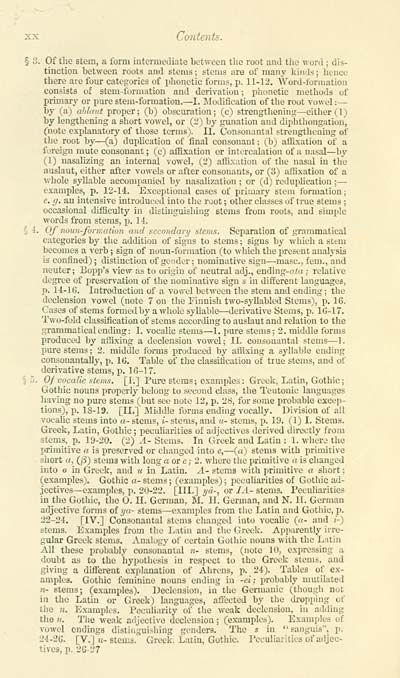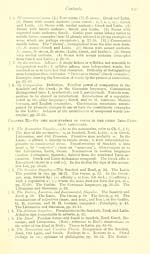Blair Collection > Celtic studies
(24)
Download files
Complete book:
Individual page:
Thumbnail gallery: Grid view | List view

XX Contents.
§ 3. Of the stem, a form intermediate between the root and tiio word ; dis-
tinction between roots and stems ; stems are of many kinds ; hence
there are four categories of plionetic forms, p. 11-12. Word-formation
consists of stem-formation and derivation; phiwietic methods of
primary or pure stem-formation. — I. JModification of the root vowel : —
by (a) ablaut proper; (b) obscuration; (c) strengthening — citlier(l)
by lengthening a sliort vowel, or (li) by guuation and diphtliongation,
(note explanatory of those terms). II. Consonantal strengthening of
tlie root by — (a) duplication of final consonant; (b) aflixation of a
foreign mute consonant ; (c) affixation or intercalation of a nasal — by
(1) nasalizing an internal vowel, (2) affixation of the nasal in the
auslaut, either after vowels or after consonants, or (3) affixation of a
whole syllable accompanied by nasalization ; or (d) redupHcation ; —
examples, p. 12-14. Exceptional cases of primary stem formation;
e. g. an intensive introduced into the root ; other classes of true stems ;
occasional difficult}' in distuiguishing stems from roots, and simple
words from stems, p. 1-1.
i. Of noun-fornuition and sccondarij stems. Separation of grammatical
categories by the addition of signs to .stems ; signs by which a stem
becomes a A-erb ; sign of noun-formation (to which the present analysis
is confined); distinction of gender; nominative sign — masc., fem., and
neuter ; Bopp's view as to origin of neutral adj., ending-ata ; relative
degree of preservation of the nominative sign s in different languages,
p. 14-lG. Introduction of a vowel between the stem and ending ; the
declension vowel (note 7 on the Finnish two-syllabled Stems), p. 16.
Cases of stems formed by a whole syllable — derivative Stems, p. 10-17.
Two-fold classification of stems according to auslaut and relation to the
grammatical ending : I. vocalic stems — 1, pure stems; 2. middle forms
produced by affixing a declension vowel; 11. consonantal stems — 1.
pure stems ; 2. middle forms produced by affixing a syllable ending
consonantally, p. IC. Table of the classification of true stems, and of
derivative stems, p. 10-17.
§ 5. Of vocalic stems. [I,] Pure stems; examples: Grcelc, Latin, Gothic;
Gothic nouns properly belong to second class, the Teutonic languages
having no pure stems (but see note 12, p. 28, for some probable excep-
tions), p. 18-19. [II,] JMiddle forms ending vocally. Division of all
vocalic stems into «- stems, I- stems, and «- stems, p. 19. (1) I. Stems.
Greek, Latin, Gothic ; peculiarities of adjectives derived directly from
stems, p. 19-20. (2) .1- Stems. In Greek and Latin : 1. where the
primitive a is preserved or changed into e, — (a) stems with primitive
short a, (/3) stems with long a or e; 2. where the primitive a is changed
into o in Greek, and u in Latin, ^i- stems with primitive a short ;
(examples). Gothic a- stems; (examples); pecuUarities of Gothic ad-
jectives — examples, p. 20-22. [III.] i/d-, or lA- stems. Peculiarities
in the Gothic, the 0. H. German, M. II. German, and N. II. German
adjective forms of yu- stems — examples from the Latin and Gothic, p.
22-2-1. [IV.] Consonantal stems changed into vocahc («- and i-)
stems. Examples from the Latin and the Greek. App;irently irre-
gular Greek stems. Analogy of certain Gothic nouns with the Latin
All these probably consonantal n- stems, (note 10, expressing a
doubt as to the hypothesis in respect to the Greek stems, and
giving a different explanation of Ahrens, p. 24). Tables of ex-
amples. Gothic feminine nouns ending in -ei: probably mutilated
n- stems; (exami)les). Declension, in the Germanic (tliough not
in the Latin or Greek) languages, afiected by the di'opping of
the 7u Examples. Peculiarity of tiie weak declension, in adding
the 71. Tlie weak adjective declension ; (examples). Examples of
vowel endings distinguishing genders. The s in "sanguis", p.
24-2C. [V.] ?i- stems. Greek, Latin, Gothic. Peculiarities of adjec-
tives, p. 20-27
§ 3. Of the stem, a form intermediate between the root and tiio word ; dis-
tinction between roots and stems ; stems are of many kinds ; hence
there are four categories of plionetic forms, p. 11-12. Word-formation
consists of stem-formation and derivation; phiwietic methods of
primary or pure stem-formation. — I. JModification of the root vowel : —
by (a) ablaut proper; (b) obscuration; (c) strengthening — citlier(l)
by lengthening a sliort vowel, or (li) by guuation and diphtliongation,
(note explanatory of those terms). II. Consonantal strengthening of
tlie root by — (a) duplication of final consonant; (b) aflixation of a
foreign mute consonant ; (c) affixation or intercalation of a nasal — by
(1) nasalizing an internal vowel, (2) affixation of the nasal in the
auslaut, either after vowels or after consonants, or (3) affixation of a
whole syllable accompanied by nasalization ; or (d) redupHcation ; —
examples, p. 12-14. Exceptional cases of primary stem formation;
e. g. an intensive introduced into the root ; other classes of true stems ;
occasional difficult}' in distuiguishing stems from roots, and simple
words from stems, p. 1-1.
i. Of noun-fornuition and sccondarij stems. Separation of grammatical
categories by the addition of signs to .stems ; signs by which a stem
becomes a A-erb ; sign of noun-formation (to which the present analysis
is confined); distinction of gender; nominative sign — masc., fem., and
neuter ; Bopp's view as to origin of neutral adj., ending-ata ; relative
degree of preservation of the nominative sign s in different languages,
p. 14-lG. Introduction of a vowel between the stem and ending ; the
declension vowel (note 7 on the Finnish two-syllabled Stems), p. 16.
Cases of stems formed by a whole syllable — derivative Stems, p. 10-17.
Two-fold classification of stems according to auslaut and relation to the
grammatical ending : I. vocalic stems — 1, pure stems; 2. middle forms
produced by affixing a declension vowel; 11. consonantal stems — 1.
pure stems ; 2. middle forms produced by affixing a syllable ending
consonantally, p. IC. Table of the classification of true stems, and of
derivative stems, p. 10-17.
§ 5. Of vocalic stems. [I,] Pure stems; examples: Grcelc, Latin, Gothic;
Gothic nouns properly belong to second class, the Teutonic languages
having no pure stems (but see note 12, p. 28, for some probable excep-
tions), p. 18-19. [II,] JMiddle forms ending vocally. Division of all
vocalic stems into «- stems, I- stems, and «- stems, p. 19. (1) I. Stems.
Greek, Latin, Gothic ; peculiarities of adjectives derived directly from
stems, p. 19-20. (2) .1- Stems. In Greek and Latin : 1. where the
primitive a is preserved or changed into e, — (a) stems with primitive
short a, (/3) stems with long a or e; 2. where the primitive a is changed
into o in Greek, and u in Latin, ^i- stems with primitive a short ;
(examples). Gothic a- stems; (examples); pecuUarities of Gothic ad-
jectives — examples, p. 20-22. [III.] i/d-, or lA- stems. Peculiarities
in the Gothic, the 0. H. German, M. II. German, and N. II. German
adjective forms of yu- stems — examples from the Latin and Gothic, p.
22-2-1. [IV.] Consonantal stems changed into vocahc («- and i-)
stems. Examples from the Latin and the Greek. App;irently irre-
gular Greek stems. Analogy of certain Gothic nouns with the Latin
All these probably consonantal n- stems, (note 10, expressing a
doubt as to the hypothesis in respect to the Greek stems, and
giving a different explanation of Ahrens, p. 24). Tables of ex-
amples. Gothic feminine nouns ending in -ei: probably mutilated
n- stems; (exami)les). Declension, in the Germanic (tliough not
in the Latin or Greek) languages, afiected by the di'opping of
the 7u Examples. Peculiarity of tiie weak declension, in adding
the 71. Tlie weak adjective declension ; (examples). Examples of
vowel endings distinguishing genders. The s in "sanguis", p.
24-2C. [V.] ?i- stems. Greek, Latin, Gothic. Peculiarities of adjec-
tives, p. 20-27
Set display mode to: Large image | Transcription
Images and transcriptions on this page, including medium image downloads, may be used under the Creative Commons Attribution 4.0 International Licence unless otherwise stated. ![]()
| Early Gaelic Book Collections > Blair Collection > Celtic studies > (24) |
|---|
| Permanent URL | https://digital.nls.uk/75771446 |
|---|
| Description | A selection of books from a collection of more than 500 titles, mostly on religious and literary topics. Also includes some material dealing with other Celtic languages and societies. Collection created towards the end of the 19th century by Lady Evelyn Stewart Murray. |
|---|
| Description | Selected items from five 'Special and Named Printed Collections'. Includes books in Gaelic and other Celtic languages, works about the Gaels, their languages, literature, culture and history. |
|---|

